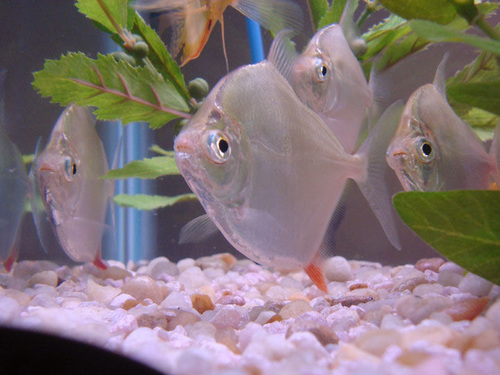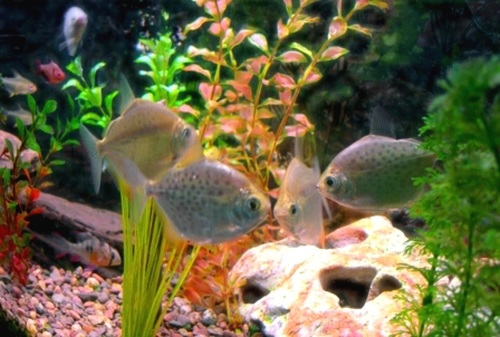TIPS FOR BREEDING SILVER DOLLAR FISH

Updated
Silver dollar fish are a great addition to the community tank and breeding them can be a fun challenge.
Silver dollar fish gained their name from their thin, flat and silvery appearance. These fish, though related to the piranha, are very peaceful community fish that do well in schools of six or more. Breeding silver dollar fish can be tricky but, if you are able to affect the right conditions, these fish can lay up to 2000 eggs at once. Red more to learn how to breed silver dollar fish in the home aquarium.
About Silver Dollar Fish
The silver dollar fish is a native of South America and, though named for a small coin, these fish can grow to more than six inches in length. Silver dollar fish make great community fish and they thrive in schools of six or more because they tend to be skittish fish and, in a school, they feel more secure. Though silver dollar fish are generally friendly toward other fish, they can be very aggressive eaters. Silver dollar fish are almost strictly vegetarian and, because of this tendency, they often feed on the live plants in an aquarium. Aside from plants, however, these fish readily consume a variety of flake, pellet, freeze dried, and frozen fish foods.

Silver Dollar Tank Requirements
Silver dollar fish are typically peaceful in the home aquarium and they are generally easy to care for. Because this fish can grow up to six inches in length, they should be kept in a tank of at least 30 gallons in capacity, especially if you plan to keep them in a school. The ideal temperature range for a silver dollar tank is between 72° and 77°F with a pH between 5.0 and 7.0. Silver dollar fish should be offered a varied diet including flake foods to provide basic nutrition supplemented with fresh vegetables and algae wafers. If you are keeping your silver dollar fish in a tank with other fish, you may need to watch out to make sure that more aggressive eaters like tetras and barbs do not keep your silver dollar fish from getting their share of the food.
90 gallons saltwater fish tank (mostly fish, little/no live coral)

State: Iowa
Country: United States
MORE INFO
Photo Caption:
My personal ocean
Fish Kept:
Humu Picasso Triggerfish, Blue Tang, Ocellaris Clownfish
Tank Size:
90 gallons
Preparing for Breeding
Like many fish, there are no distinctly obvious means of distinguishing between a male and female silver dollar fish. The only way to tell the sex of a silver dollar fish is to study the anal fin. In a male silver dollar fish, the anal fin may be slightly longer and may also be tinged red. Because it is difficult to sex silver dollar fish, the best way to prepare for breeding them is to purchase six or so juvenile fish and raise them together. This will allow the juvenile fish to grow together and to form bonds with other fish and to establish breeding pairs.

Once the fish have reached sexual maturity, set up a separate breeding tank and, if you want, a separate tank to raise the fry. The breeding tank should be dimly lit and kept at a temperature around 80 degrees Fahrenheit. Silver dollar fish are generally tolerant of different water qualities but they do best in a slightly acidic tank with soft water, 8 dgH or less. These fish also prefer the lighting to be dim in the breeding tank.
Unlike many egg layers, silver dollar fish do not build bubble nests so it is best to fill the breeding tank with fine-leafed plants. These plants will provide protection for the eggs and may also serve as a food source for the adult fish and the fry as they grow. You should keep in mind, however, that silver dollar fish tend to feed voraciously on plants. This being the case, you should stock fast-growing plants or consider using fake plants in your breeding tank. If you don’t plan to keep the adults in the breeding tank after spawning, however, you may be able to get away with using more traditional tropical plants.
Breeding and Spawning
As it has already been mentioned, silver dollar fish are an egg-laying variety of fish. When the female lays eggs she will lay up to 2000 at once and the male will then fertilize them. During breeding, the male will typically chase the female around for a while until she allows him to come beside her. The male will then flick his body against hers, releasing his sperm at the same moment that she begins to release her eggs. In some cases, the male may wrap his body around the female’s, fertilizing the eggs as they are released. Because silver dollar fish are herbivores, they do not tend to eat their own eggs so it is safe to keep the adults in the tank with the eggs if you choose to do so.
After three days or so the fry will hatch and will begin to swim around the tank. Like any fry, newly hatched silver dollar fish need to be fed a diet of very fine foods like brine shrimp, crushed spirulina, or specially formulated fry foods. If you feed the fry regularly during the first few days of life they will grow quickly and will have a greater chance of developing into healthy adults. Fry that are not fed adequately during the first few days after hatching often experience stunted growth and they may never achieve full size at maturity.
Though breeding silver dollar fish can be tricky at times, it is well worth the effort. Not only are these fish uniquely beautiful but they make great additions to the community tank. Silver dollar fish do not antagonize other species of fish and they will not eat the eggs or fry of other fish in your tank. Beware, however, that these fish are ravenous eaters of plant life so if you plan to keep them in your aquarium be sure to stick to either plastic plants or hardier varieties of live plants.
Conclusion
Breeding aquarium fish of any species is not impossible, though it does take some time and preparation. Silver dollar fish, in particular, can be tricky to breed at home because you must raise them in groups if you want them to breed. If you provide your fish with the ideal habitat and a healthy diet, however, you should be able to successfully breed your silver dollars.
comments powered by Disqus







































































































































